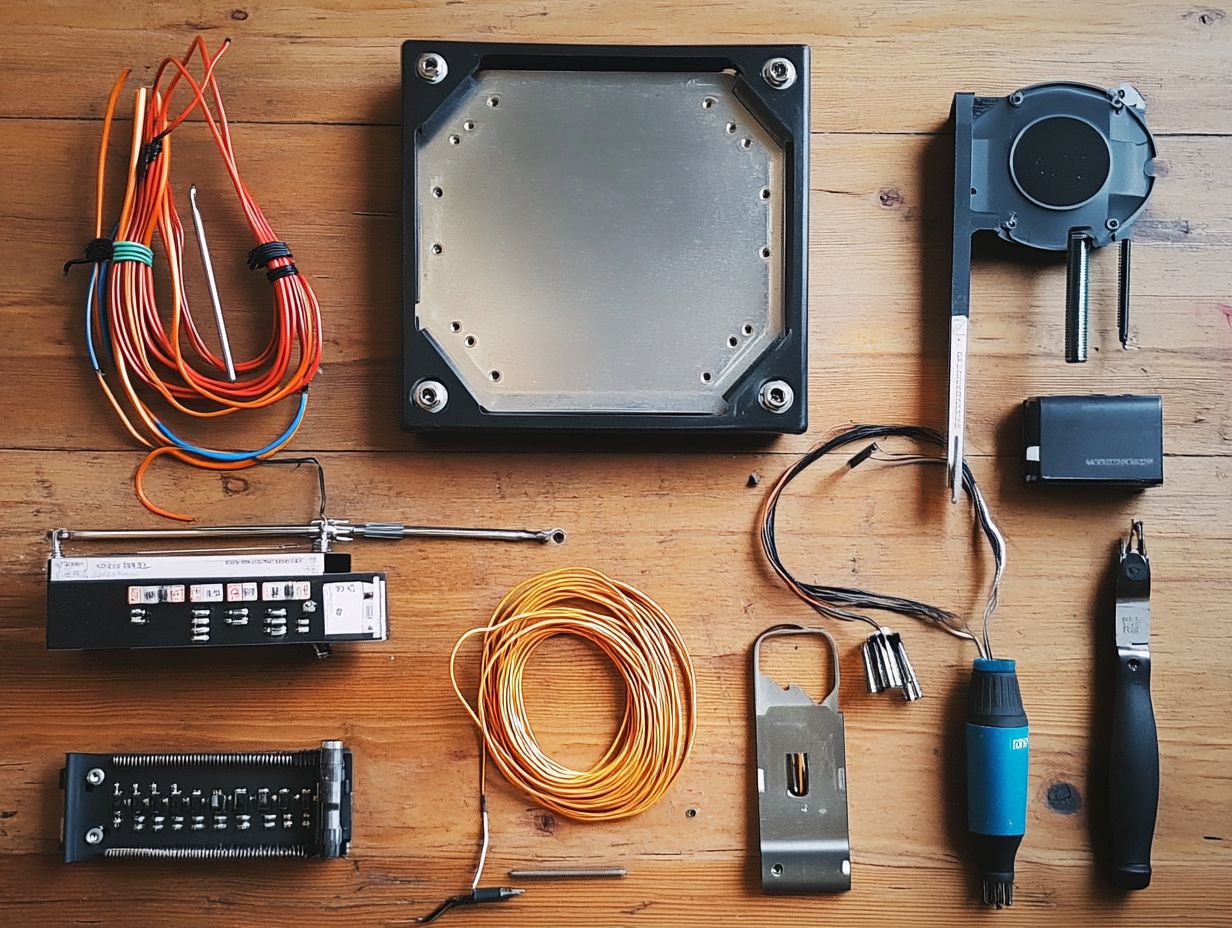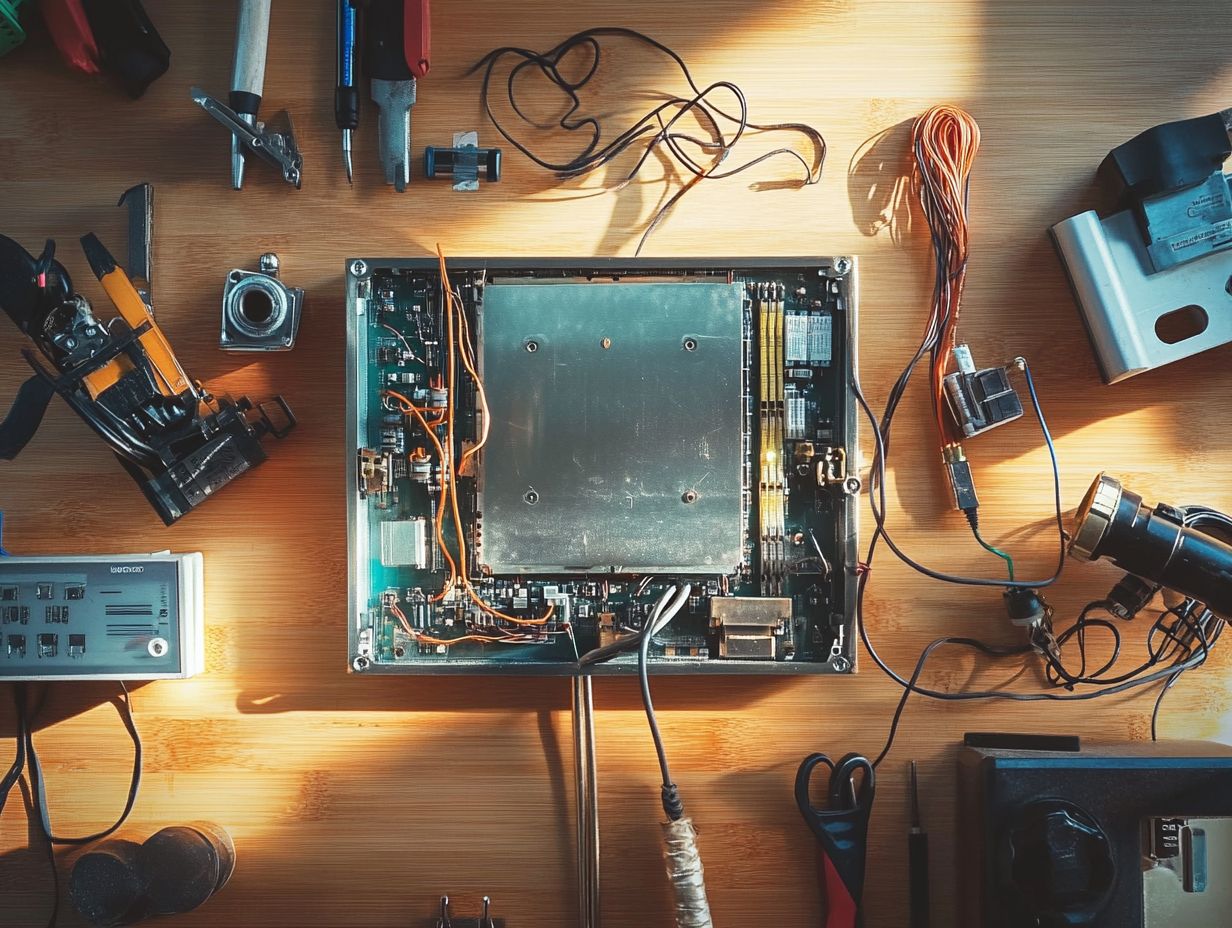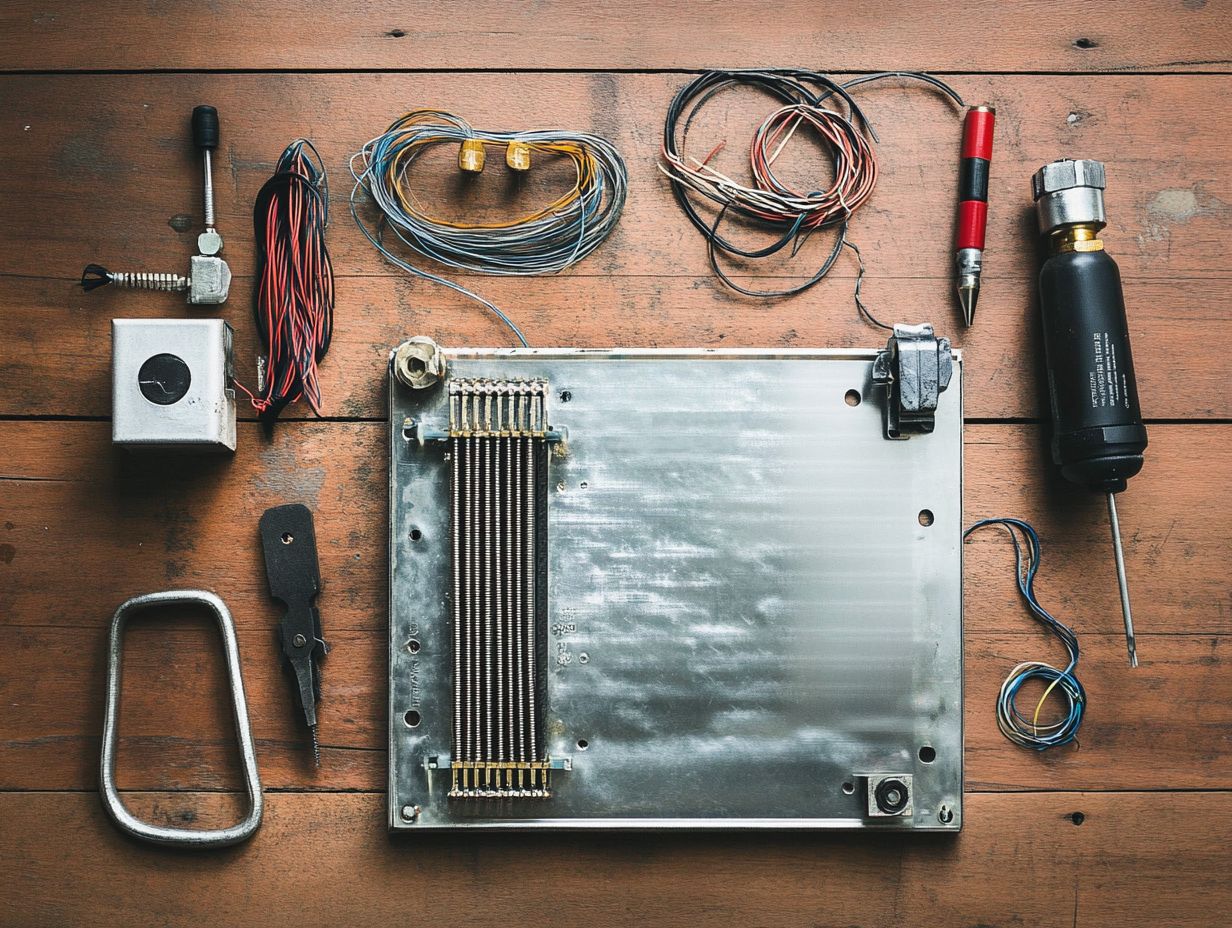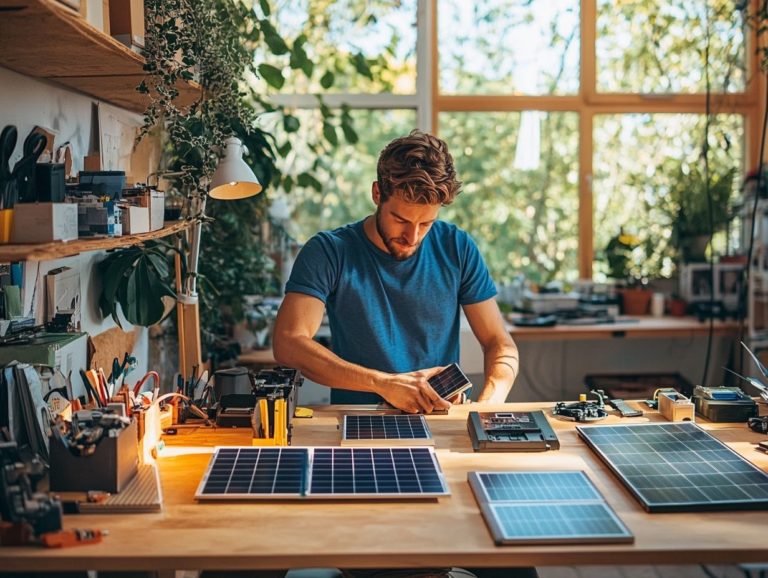How to Create a Homemade Thermoelectric Generator
Imagine tapping into the incredible power of heat to generate electricity what if a homemade thermoelectric generator (TEG) or even a simple heat engine could be your key to this innovation?
This article delves into the advantages of constructing your own TEG, highlighting the potential for cost savings and the freedom to customize your device according to your unique needs.
You’ll find a thorough list of materials required, along with an easy-to-follow step-by-step guide that will lead you through the creation process.
You will also discover practical applications, such as using candles and a hot plate to create temperature differences, that can make your TEG even more useful, along with crucial safety considerations to keep in mind as you embark on this exciting project.
Get ready to unleash the exciting power of thermoelectric energy!
Contents
- Key Takeaways:
- Benefits of a Homemade Thermoelectric Generator
- Materials Needed for Building a Homemade Thermoelectric Generator
- Step-by-Step Guide to Building a Homemade Thermoelectric Generator
- Uses for a Homemade Thermoelectric Generator
- Safety Considerations for Operating a Homemade Thermoelectric Generator
- Precautions and Potential Risks
- Frequently Asked Questions
- 1. What materials do I need to create a homemade thermoelectric generator?
- 2. Can I use any heat source for a homemade thermoelectric generator?
- 3. How do I connect the thermoelectric modules in my homemade generator?
- 4. Can I adjust the power output of my homemade thermoelectric generator?
- 5. Do I need any special tools to create a homemade thermoelectric generator?
- 6. Can I use a homemade thermoelectric generator to power my entire home?
Key Takeaways:

- Save money by building your own thermoelectric generator, allowing for customization and efficiency with materials like copper and nichrome wire.
- Ensure safety and efficiency by following specific instructions and using the right materials during construction.
- Utilize your homemade generator for off-grid power or emergencies, possibly incorporating a battery for energy storage.
Discover the Magic of Thermoelectric Generators!
A thermoelectric generator (TEG) is a remarkable solid-state device that turns heat into electricity by leveraging the principles of the Seebeck and Peltier effects. These effects describe how heat can create electricity and how electricity can generate heat. This innovative technology taps into the intricate relationship between heat transfer and charge separation to generate electric current, making it an invaluable asset for energy generation across a spectrum of applications from powering small gadgets to supplying energy to spacecraft like Voyager and Cassini. Thomas Seebeck discovered the Seebeck effect that forms the basis of these devices.
By harnessing the temperature gradient between hot and cold surfaces, thermoelectric generators produce electricity with impressive efficiency and without any moving parts. This design not only minimizes mechanical wear but also reduces maintenance needs.
The Seebeck effect creates voltage from heat differences, while the Peltier effect cools or heats materials when electricity flows through them. Different combinations of metals and semiconductors can be used to optimize this effect.
These devices find their place in a variety of fields, from automotive systems focusing on waste heat recovery to the renewable energy sector, promoting energy efficiency by converting excess heat into usable power. This process minimizes energy loss and significantly contributes to sustainable practices.
Benefits of a Homemade Thermoelectric Generator
Crafting a homemade thermoelectric generator presents you with a host of advantages. Not only can you achieve substantial cost savings compared to commercial models, but you also gain the freedom to customize the device according to your specific energy generation requirements.
Beyond the practical benefits, there’s a unique satisfaction that comes from diving into DIY projects, allowing you to enhance your skills and deepen your understanding of thermoelectric technology. For example, experimenting with different metal combinations can lead to improved energy efficiency.
Cost Savings and Customization
Building your own thermoelectric generator offers significant cost savings. You can source materials like copper wire and aluminum at much lower prices than pre-made devices. This flexibility allows you to tailor the design to optimize energy efficiency according to your specific needs. You can also incorporate a voltage regulator to manage the output effectively.
By selecting readily available materials, you not only slash expenses but also gain the freedom to customize your generator. For example, modifying the insulation can greatly affect performance; you might choose different insulating materials to enhance heat retention, making your system more effective. A temperature sensor can help you monitor and optimize the temperature gradient.
Get ready to explore various components! You can choose specific thermoelectric materials that align with your energy output requirements. For those interested in DIY projects, learning how to make a homemade heat pump can be a great option. The layout is yours to tweak, allowing you to arrange your design for maximum heat exchange efficiency.
This level of customization empowers you to innovate and refine your project. You can create a generator that perfectly meets your energy demands. By considering factors such as thermal noise and thermal mass, you can further enhance your design for optimal performance.
Materials Needed for Building a Homemade Thermoelectric Generator

To successfully construct a homemade thermoelectric generator, gather an array of crucial materials for optimal performance. Start with copper wire for your electrical connections, ensuring efficient conductivity.
Aluminum is an excellent choice for heat sinks. Nichrome wire serves as your heating elements. Don’t forget insulation tape for proper thermal management and thermal paste to optimize heat transfer between your components.
You need an electric motor to convert mechanical energy into electrical energy, completing your setup for a successful project. Using ice cubes and hot water creates the necessary temperature gradient for generating power.
List of Required Materials
To build a thermoelectric generator, gather these essential materials: an aluminum tray for the heat sink, copper wire for electrical connections, nichrome wire for heating elements, insulation tape for managing thermal gradients, thermal paste for optimizing heat transfer, and a voltmeter for measuring voltage output.
Each component plays a pivotal role in ensuring efficient operation. The aluminum tray effectively dissipates heat while providing sturdy support. Copper wire is key due to its superb conductivity, facilitating seamless energy conversion.
Nichrome wire is ideal for high-temperature resistance, acting as the heating element that creates necessary thermal gradients for thermoelectric generation. Insulation tape keeps that heat where you need it, maintaining high energy efficiency.
Thermal paste enhances contact between heat sources and thermoelectric materials, improving heat transfer. Don’t overlook the voltmeter; it’s crucial for monitoring output and ensuring your generator functions optimally.
You can easily find these materials at your local hardware store or online marketplaces, with many cost-effective alternatives to fit various budgets.
Step-by-Step Guide to Building a Homemade Thermoelectric Generator
This comprehensive guide takes you through the meticulous process of constructing your very own homemade thermoelectric generator. Each step ensures you understand how to convert temperature differences into usable electrical energy.
By following this guide, you empower yourself to harness innovative energy generation techniques, paving the way for a new realm of possibilities in sustainable energy.
Start gathering your materials today and unleash your creativity in energy generation!
Instructions and Tips
Your safety is paramount! Follow these guidelines to build your generator with confidence. When you’re following the instructions for building your thermoelectric generator, keep safety considerations at the forefront. Handle materials like nichrome wire and thermal components with care to avoid accidents. Use practical tips to improve how the device works. Following the project steps meticulously will ensure a safe and efficient build.
Understanding how to connect each component effectively is a game-changer for overall efficiency. Start by assembling the heat sink and the thermoelectric modules with precision. Ensuring a tight fit is crucial for promoting effective heat transfer. When it’s time to apply thermal paste, spread it evenly. This enhances conductivity and helps prevent overheating. Using an infrared image can help you monitor heat distribution effectively.
Managing insulation effectively prevents heat loss, which could otherwise diminish your generator’s power output. For long-term durability, opt for high-quality materials and routinely inspect connections for signs of wear. Maintain proper safety practices throughout your assembly process wear gloves and goggles to protect yourself from potential hazards. Your diligence will pay off in both performance and safety.
Uses for a Homemade Thermoelectric Generator

A homemade thermoelectric generator can serve a multitude of purposes. It can power small devices and provide energy solutions in remote locations. Its ability to contribute to thermoelectric cooling systems further highlights its versatility and practicality in daily life. Integrating a voltmeter and voltage measurement tools helps you monitor and optimize your energy output.
Whether you re looking to harness energy in innovative ways or address specific energy needs, this generator has the potential to elevate your experience.
Practical Applications and Potential Benefits
A thermoelectric generator can power LED lighting, charge batteries, and provide energy for small electronic devices. The benefits are substantial: enjoy increased energy efficiency, a reduced reliance on traditional power sources, and innovative cooling systems that expertly manage heat dissipation. In emergencies, a radioisotope thermoelectric generator which uses heat from radioactive substances to generate electricity can be a reliable backup power source.
Beyond these common applications, thermoelectric generators are making impressive inroads in scientific research, particularly in remote sensing scenarios where conventional power sources simply won’t do. For example, in space missions, these generators capitalize on the heat from radioactive decay to reliably produce electricity an essential resource for powering instruments aboard satellites, rovers, and other spacecraft.
The remarkable ability to convert waste heat from industrial processes into usable energy presents significant commercial opportunities. This transformation helps companies enhance sustainability and slashes operational costs. By embracing thermoelectric technology across various sectors, you pave the way for innovative thermoelectric cooling systems that not only elevate performance but also extend the lifespan of components in high-heat environments.
Safety Considerations for Operating a Homemade Thermoelectric Generator
Operating a homemade thermoelectric generator can be a rewarding DIY project, but it requires awareness of essential safety considerations. Take precautions to prevent electrical hazards stemming from the electric current generated, and recognize the potential risks associated with handling hot components.
By prioritizing these safety measures, you can ensure that you operate your device safely and effectively.
Start building your thermoelectric generator today and experience the thrill of creating your own energy source!
Precautions and Potential Risks
To ensure the safe operation of your thermoelectric generator, it is essential to implement precautions such as proper electrical safety measures and effective heat management practices. This will help prevent potential risks like electrical shock and overheating during energy generation.
Start by using insulated tools whenever you connect or disconnect wires; this simple step greatly minimizes the risk of electric shock. Ensure that all electrical connections are secure and well-insulated to prevent any short circuits from occurring. Using insulation tape secures wiring and boosts safety.
Keep a safe distance from heat sources to protect both yourself and your generator! Overheating can damage the generator and even pose a fire risk. Regularly check components for signs of wear or damage to identify potential problems before they escalate. Utilize a temperature sensor to monitor heat levels and ensure your thermoelectric generator operates within safe limits.
Always operate the generator in a well-ventilated area to effectively disperse heat and gases. Investing in a reliable thermometer to monitor temperature levels will enable you to maintain safe operational parameters. For added safety, measure the voltage difference periodically to avoid any electrical issues.
Frequently Asked Questions

1. What materials do I need to create a homemade thermoelectric generator?
To create a homemade thermoelectric generator, you will need thermoelectric modules, heat sinks, a power source, wiring, and a power management system. You may also need additional materials like thermal paste, copper wire, aluminum tray, and insulation tape depending on the specific design and purpose of your generator.
2. Can I use any heat source for a homemade thermoelectric generator?
Yes, you can use a variety of heat sources such as a campfire, stove, or even body heat to power your thermoelectric generator. However, the efficiency of the generator may vary depending on the temperature and consistency of the heat source. For example, using a hot plate or candles can provide a consistent heat source, thereby improving efficiency.
3. How do I connect the thermoelectric modules in my homemade generator?
The thermoelectric modules should be connected in series, with the positive (red) terminal of one module connected to the negative (black) terminal of the next. This creates a continuous flow of electricity through the modules, which can then be harnessed for power. Ensure you use a voltage regulator (a device that helps control the amount of electricity produced) to manage the power output efficiently.
4. Can I adjust the power output of my homemade thermoelectric generator?
Yes, the power output of a thermoelectric generator can be adjusted by changing the temperature differential between the hot and cold sides of the generator. The larger the difference in temperature, the greater the power output. Consider using cold water or ice cubes on the cold side and a hot plate on the hot side to maximize the temperature gradient.
Ready to start your project? Gather your materials and get started today!
5. Do I need any special tools to create a homemade thermoelectric generator?
You don t need special tools, but a soldering iron and wire cutters can help. You can create a functional thermoelectric generator using common household tools like pliers, a screwdriver, and wire strippers. A voltmeter helps you measure the electric output and fix any problems.
6. Can I use a homemade thermoelectric generator to power my entire home?
A homemade thermoelectric generator can’t supply electricity for an entire house. However, it s great for powering small devices or charging batteries, making it a useful option for off-grid living or emergencies. Use it to power LED lighting or small appliances!





